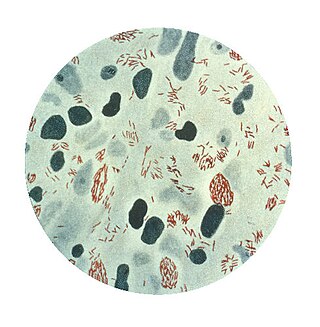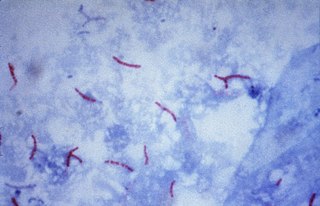Related Research Articles

Bacillus is a genus of Gram-positive, rod-shaped bacteria, a member of the phylum Bacillota, with 266 named species. The term is also used to describe the shape (rod) of other so-shaped bacteria; and the plural Bacilli is the name of the class of bacteria to which this genus belongs. Bacillus species can be either obligate aerobes which are dependent on oxygen, or facultative anaerobes which can survive in the absence of oxygen. Cultured Bacillus species test positive for the enzyme catalase if oxygen has been used or is present.

In bacteriology, gram-positive bacteria are bacteria that give a positive result in the Gram stain test, which is traditionally used to quickly classify bacteria into two broad categories according to their type of cell wall.
A human pathogen is a pathogen that causes disease in humans.

Leprosy, also known as Hansen's disease (HD), is a long-term infection by the bacteria Mycobacterium leprae or Mycobacterium lepromatosis. Infection can lead to damage of the nerves, respiratory tract, skin, and eyes. This nerve damage may result in a lack of ability to feel pain, which can lead to the loss of parts of a person's extremities from repeated injuries or infection through unnoticed wounds. An infected person may also experience muscle weakness and poor eyesight. Leprosy symptoms may begin within one year, but, for some people, symptoms may take 20 years or more to occur.

Gerhard Henrik Armauer Hansen was a Norwegian physician, remembered for his identification of the bacterium Mycobacterium leprae in 1873 as the causative agent of leprosy. His distinguished work was recognized at the International Leprosy Congress held at Bergen in 1909.

Mycobacterium tuberculosis, also known as Koch's bacillus, is a species of pathogenic bacteria in the family Mycobacteriaceae and the causative agent of tuberculosis. First discovered in 1882 by Robert Koch, M. tuberculosis has an unusual, waxy coating on its cell surface primarily due to the presence of mycolic acid. This coating makes the cells impervious to Gram staining, and as a result, M. tuberculosis can appear weakly Gram-positive. Acid-fast stains such as Ziehl–Neelsen, or fluorescent stains such as auramine are used instead to identify M. tuberculosis with a microscope. The physiology of M. tuberculosis is highly aerobic and requires high levels of oxygen. Primarily a pathogen of the mammalian respiratory system, it infects the lungs. The most frequently used diagnostic methods for tuberculosis are the tuberculin skin test, acid-fast stain, culture, and polymerase chain reaction.

Mycobacterium is a genus of over 190 species in the phylum Actinomycetota, assigned its own family, Mycobacteriaceae. This genus includes pathogens known to cause serious diseases in mammals, including tuberculosis and leprosy in humans. The Greek prefix myco- means 'fungus', alluding to this genus' mold-like colony surfaces. Since this genus has cell walls with a waxy lipid-rich outer layer that contains high concentrations of mycolic acid, acid-fast staining is used to emphasize their resistance to acids, compared to other cell types.

Mycobacterium leprae is one of the two species of bacteria that cause Hansen’s disease (leprosy), a chronic but curable infectious disease that damages the peripheral nerves and targets the skin, eyes, nose, and muscles.

The Ziehl-Neelsen stain, also known as the acid-fast stain, is a bacteriological staining technique used in cytopathology and microbiology to identify acid-fast bacteria under microscopy, particularly members of the Mycobacterium genus. This staining method was initially introduced by Paul Ehrlich (1854–1915) and subsequently modified by the German bacteriologists Franz Ziehl (1859–1926) and Friedrich Neelsen (1854–1898) during the late 19th century.

The bacterial capsule is a large structure common to many bacteria. It is a polysaccharide layer that lies outside the cell envelope, and is thus deemed part of the outer envelope of a bacterial cell. It is a well-organized layer, not easily washed off, and it can be the cause of various diseases.
The lepromin skin test is used to determine what type of leprosy a person is infected with. It involves the injection of a standardized extract of the inactivated "leprosy bacillus" under the skin. It is not recommended as a primary mode of diagnosis.

Ribosomal ribonucleic acid (rRNA) is a type of non-coding RNA which is the primary component of ribosomes, essential to all cells. rRNA is a ribozyme which carries out protein synthesis in ribosomes. Ribosomal RNA is transcribed from ribosomal DNA (rDNA) and then bound to ribosomal proteins to form small and large ribosome subunits. rRNA is the physical and mechanical factor of the ribosome that forces transfer RNA (tRNA) and messenger RNA (mRNA) to process and translate the latter into proteins. Ribosomal RNA is the predominant form of RNA found in most cells; it makes up about 80% of cellular RNA despite never being translated into proteins itself. Ribosomes are composed of approximately 60% rRNA and 40% ribosomal proteins by mass.
Mycolic acids are long fatty acids found in the cell walls of Mycobacteriales taxon, a group of bacteria that includes Mycobacterium tuberculosis, the causative agent of the disease tuberculosis. They form the major component of the cell wall of many Mycobacteriales species. Despite their name, mycolic acids have no biological link to fungi; the name arises from the filamentous appearance their presence gives Mycobacteriales under high magnification. The presence of mycolic acids in the cell wall also gives Mycobacteriales a distinct gross morphological trait known as "cording". Mycolic acids were first isolated by Stodola et al. in 1938 from an extract of M. tuberculosis.
The rpoB gene encodes the β subunit of bacterial RNA polymerase and the homologous plastid-encoded RNA polymerase (PEP). It codes for 1342 amino acids in E. coli, making it the second-largest polypeptide in the bacterial cell. It is targeted by the rifamycin family of antibacterials, such as rifampin. Mutations in rpoB that confer resistance to rifamycins do so by altering the protein's drug-binding residues, thereby reducing affinity for these antibiotics.

Mycobacterium kansasii is a bacterium in the Mycobacterium genus. It is an environmental bacteria that causes opportunistic infections in humans, and is one of the leading mycobacterial causes of human disease after tuberculosis and leprosy.

16S ribosomal RNA is the RNA component of the 30S subunit of a prokaryotic ribosome. It binds to the Shine-Dalgarno sequence and provides most of the SSU structure.

Lepromatous leprosy is a form of leprosy characterized by pale macules in the skin.
Thermodesulfobacterium hveragerdense is a bacterial species belonging to genus Thermodesulfobacterium, which are thermophilic sulfate-reducing bacteria. This species is found in aquatic areas of high temperature, and lives in freshwater like most, but not all Thermodesulfobacterium species It was first isolated from hotsprings in Iceland.

Mycobacterium ulcerans is a species of bacteria found in various aquatic environments. The bacteria can infect humans and some other animals, causing persistent open wounds called Buruli ulcer. M. ulcerans is closely related to Mycobacterium marinum, from which it evolved around one million years ago, and more distantly to the mycobacteria which cause tuberculosis and leprosy.
Mycolicibacillus is a genus of Gram-Positive rod-shaped bacteria in the family Mycobacteriaceae from the order Mycobacteriales.
References
- ↑ "Mycobacterium lepromatosis Han et al. 2008, effective name". NCBI Taxonomy Browser. NCBI:txid480418. Retrieved 16 May 2023. Via Schoch CL, et al. NCBI Taxonomy: a comprehensive update on curation, resources and tools. Database (Oxford). 2020: baaa062. PMID 32761142 PMC 7408187.
- 1 2 3 4 Han XY, Sizer KC, Thompson EJ, Kabanja J, Li J, Hu P, et al. (October 2009). "Comparative sequence analysis of Mycobacterium leprae and the new leprosy-causing Mycobacterium lepromatosis". Journal of Bacteriology. 191 (19): 6067–6074. doi:10.1128/JB.00762-09. PMC 2747882 . PMID 19633074.
- 1 2 3 Percival, Steven L.; Williams, David W. (2014), "Mycobacterium", Microbiology of Waterborne Diseases, Elsevier, pp. 177–207, doi:10.1016/b978-0-12-415846-7.00009-3, ISBN 978-0-12-415846-7 , retrieved 2022-11-17
- 1 2 3 Meehan CJ, Barco RA, Loh YE, Cogneau S, Rigouts L (September 2021). "Reconstituting the genus Mycobacterium". International Journal of Systematic and Evolutionary Microbiology. 71 (9). doi:10.1099/ijsem.0.004922. PMC 8549266 . PMID 34554081.
- 1 2 3 Han XY, Seo YH, Sizer KC, Schoberle T, May GS, Spencer JS, et al. (December 2008). "A new Mycobacterium species causing diffuse lepromatous leprosy". American Journal of Clinical Pathology. 130 (6): 856–864. doi: 10.1309/AJCPP72FJZZRRVMM . PMID 19019760.
- "Researchers identify new leprosy bacterium". EurekAlert! (Press release). 24 November 2008.
- ↑ Dermatologic Manifestations of Leprosy at eMedicine
- ↑ Han XY, Seo YH, Sizer KC, Schoberle T, May GS, Spencer JS, et al. (December 2008). "A new Mycobacterium species causing diffuse lepromatous leprosy". American Journal of Clinical Pathology. 130 (6): 856–864. doi: 10.1309/AJCPP72FJZZRRVMM . PMID 19019760.
- ↑ Miyamoto Y, Mukai T, Matsuoka M, Kai M, Maeda Y, Makino M (August 2016). Johnson C (ed.). "Profiling of Intracellular Metabolites: An Approach to Understanding the Characteristic Physiology of Mycobacterium leprae". PLOS Neglected Tropical Diseases. 10 (8): e0004881. doi: 10.1371/journal.pntd.0004881 . PMC 4968842 . PMID 27479467.